Celts and Christianity

Figure 1. St Columba founded his monastery in Iona in AD 563. He was the first of numerous missionaries and scholars who, as shown on the map, established centers of sanctity and learning in Western Europe. The movement was represented by such figures as Aidan in England (635), Columba, in France, Switzerland and Italy from (590), Feuillen in Belgium (c. 650), Killan in central Germany (martyred c. 689) and Fearghal in Austria (mid-8th century). Many of the Irish exiles were scholars, or monks wanting to evangelise the new pagan tribes who had overrun the Roman Empire.
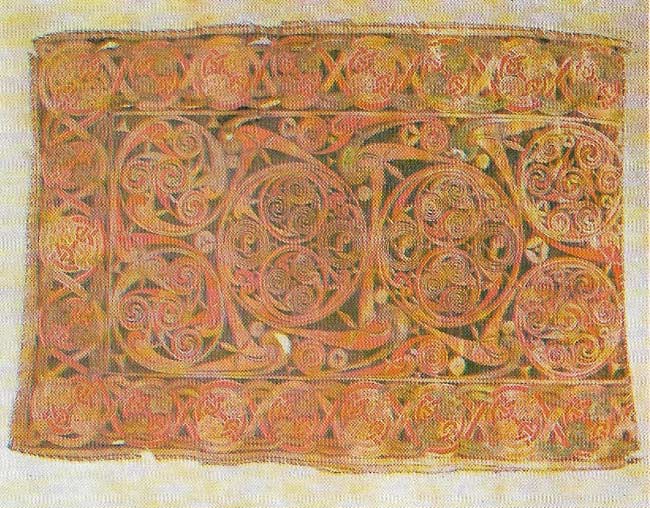
Figure 2. Illuminated manuscripts are one of the great glories of European art, as this page from the 7th-century Book of Durrow shows. As Ireland remained untouched by the Roman Empire, its art retained its original style.
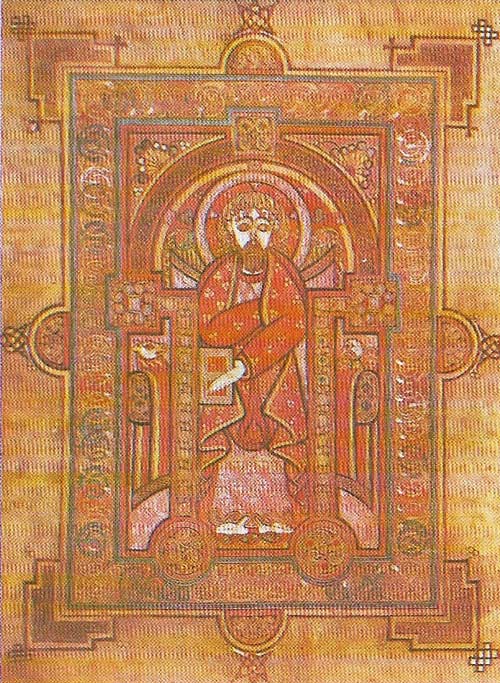
Figure 3. The great period of Irish manuscript illumination was from the late seventh to the early 9th centuries AD. In these unique works, vitality in the design is combined with austere representations of divine figures, showing by their elongated, sombre faces their long link with the Celtic past. In the Book of Kells, St Matthew is surrounded by decorated panels and motifs, which were familiar from the art of Ireland's pagan past.
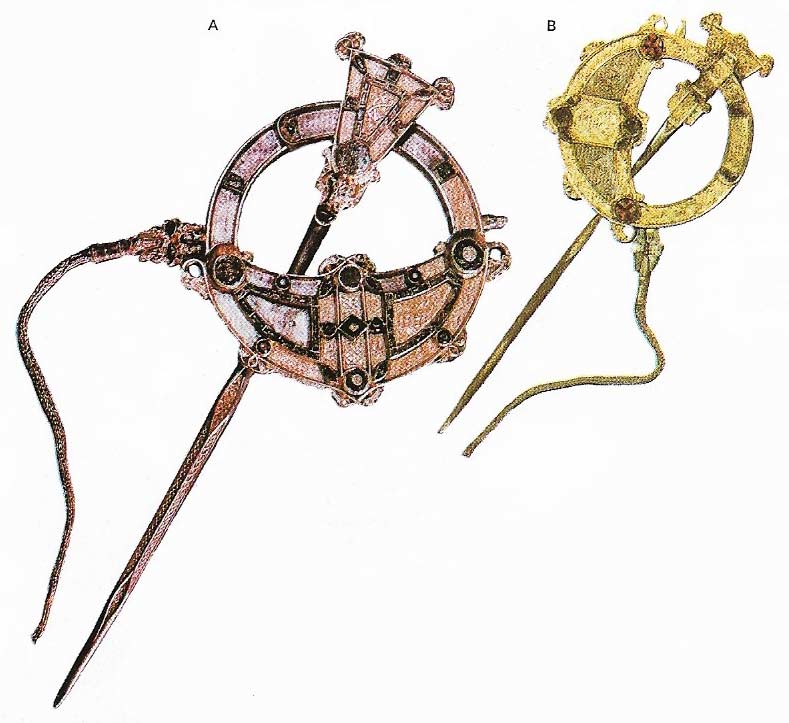
Figure 4. The finest of all Irish brooches is the Tara brooch (A) (c. early eighth century). Both sides of the brooch are richly decorated, the back (B) being in a better state of preservation than the front.

Figure 5. The Ardagh Chalice (A) was found in Co Limerick in Ireland. The contrast of plain surface (silver) decorated with studs and gold filigree makes a striking impact. One of the more beautiful details is on the underside (B) of the foot of the bowl.
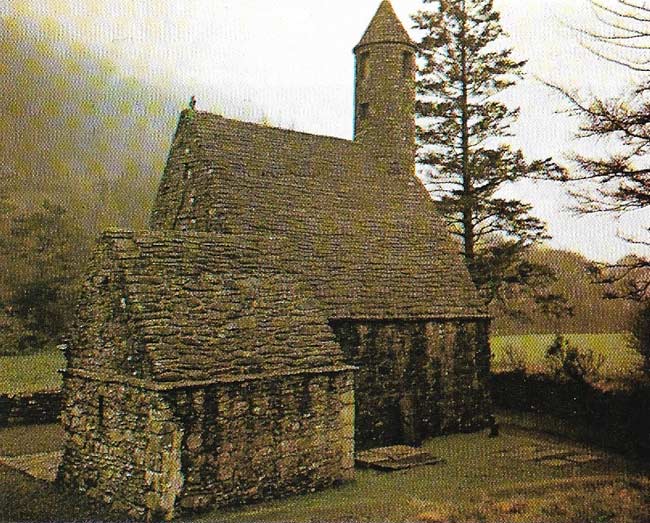
Figure 6. Glendalough in Co Wicklow was a place of beauty and sanctity, sacred to St Kevin. Known as St Kevin's Kitchen (c. ninth century), the building has a vaulted ceiling which supports a corbelled roof in an ingenious manner. Small ecclesiastic buildings of this kind were probably widely distributed in early Christian Ireland, providing testimony to the spread of Christianity in that remote region, far from Rome.
Prior to the Roman conquest much of western and Central Europe was dominated by Celtic tribes of Indonesia-European origin. Skilled in the use of iron, which they introduced into Northern Europe, the Celts flourished from about 700 BC. They achieved a high level of material culture and also developed a highly complex religion and mythology which formed an integral part of their society. Celtic art reflected the importance of religion, and geometrical or magic symbols and cult animals are repeated on objects from all periods of Celtic history – pagan and Christian alike.
The finest phase of Celtic culture
Celtic culture reached its finest achievements during the La Tene period which began in about 500 BC and, in Europe, lasted until its absorption by Rome. Information about the Celts of this period is obtained both from archaeological evidence and also from Greek and Roman authors. They have recorded details of tribes, all of which give important information about the Celtic languages, which have survived in a modified but recognizable form in Britain, Ireland and Brittany.
The Celts did not commit their religious beliefs and traditional learning to writing until after the arrival of Christianity in Ireland in the fifth century. The comments of the classical writers of the time when Rome's armies destroyed the Celtic world in Europe therefore have a unique importance. Almost fanatical in their religious fervor, the pagan Celts were dominated by powerful, highly aristocratic priests, the Druids, who often combined the role of king with their priesthood. Tribal in social organization, the Celts also possessed the oldest and most complex legal system in Europe. Every man had his rights, and crimes from murder to the smallest wrong were listed and categorized.
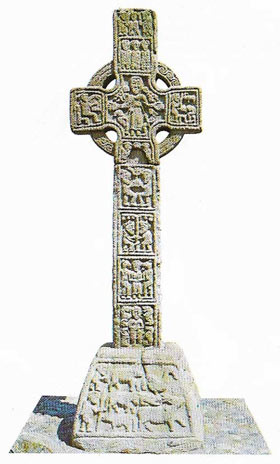 |
| High crosses were free-standing monuments decorated with Christian or pagan symbols. One of the finest is the 9th-century South Cross at Castledermot, Co Kildare. These crosses presumably stood in the monastic precincts and were of varying heights with the wheel-shaped arcs joining the arms and shaft, and set on a substantial base. |
Celtic spiritual tradition
The Celts were highly conservative in matters of tradition. Non-literate, they had a complex oral tradition and were natural scholars with a deep admiration for intellectual power and a passionate love of words. The beauty of nature is depicted in some of their richest poems; its appeal to the Celts came at a time when their neighbors had little care for such intense spirituality.
It is understandable then that Christianity had such an early widespread success in Ireland, the only country in Western Europe to be totally untouched by Roman arms. Ireland fell in the 5th century, not to disciplined Roman soldiers, but to the equally disciplined Roman Church. All the Celtic fervor for religion was now transferred to the service of Christianity – a very Celtic type of Christianity, noted for its austere devotions and the selfless dedication of its clerics. The detailed and sophisticated laws were now transformed for Christian purposes; the glorious art once used to adorn the pagan warriors and their shrines and honour the gods now served to praise God in the form of superbly illuminated manuscripts (Figures 2 and 3), the old pagan symbolism of spirals and circles taking on a new meaning.
In a Europe torn by invasion and disaster of every kind, Ireland remained a haven of peace and learning, far from the terrible ravages of the northern barbarians who from 400 were burning the churches and the towns of Europe and desecrating and destroying all that was sacred and beautiful. The early Irish Church favoured the monastic system and during the 5th and 6th centuries monasteries sprang up throughout Ireland.
The Age of Saints
This long period of tranquility and learning was known as the Age of Saints. It was a time when the churchmen and their guests were occupied in studying the Gospels and illuminating the manuscripts, while the Christian scribes were busily committing to writing the old pagan oral traditions and poems of their country for, although Christians, they were also Celts and loyalty to the archaic traditions of their old and much-loved country was strong.
Only the coming of the Viking's at the end of the 8th century broke the spell that had made Ireland the cultural center of the Western world. In the sixth and seventh centuries many Irish churchmen, such as St Columba (521–597), Aidan (died 651) and St Columban (543–615) travelled far over Europe, founding monasteries and churches, converting the heathen, teaching in the courts, establishing their own schools and inspiring all who came into contact with them by their austere devotion to their calling (Figure 1). Following the Viking invasion, exiled monks continued to travel throughout Europe.
Their rich literature and that of their neighbors, the Welsh, profoundly influenced the evolution of medieval literature and provided new and thrilling themes for the enrichment of the troubadours' repertoires for the entertainment of the rich courts of later medieval Europe.
The Celtic story in Europe does not end in the romances of the courts of Eleanor of Aquitaine and her contemporaries in the twelfth century. In the 18th century the famous Ossianic controversy fascinated Europe. Although the poems of the legendary Gaelic bard, Ossian, were subsequently proved to be a mixture of traditional Gaelic folk poetry and poems attributed to James Macpherson (1736–1796) they nevertheless inspired writers, painters, musicians and antiquarians with a fresh interest in the Celts.
 |
| This two-faced stone figure from Boa Island in County Fermanagh dates from the 1st century BC. It forms a link with the old pagan world of the Celtic past and the flowering of Celtic religious and artistic genius in the Christian era. It is impossible to say how long paganism lingered in Ireland after the arrival of Christianity. As Roman law and administration never interrupted the traditions of tribal life and religious awareness, the transition from pagan gods to the Christian God was complicated by the survival of some elements of Celtic pagan tradition. But by the fifth century, Christianity was firmly established. |
